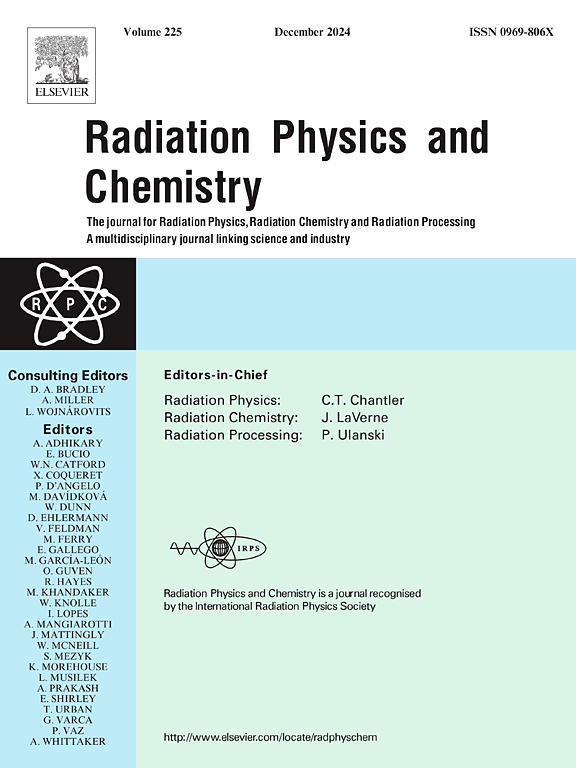Enhancing the gamma radiation shielding performance: The impact of Bi2O3 and MgO nanoparticles on PMMA
IF 2.8
3区 物理与天体物理
Q3 CHEMISTRY, PHYSICAL
引用次数: 0
Abstract
This work investigated the gamma radiation shielding performance of different nano-composites (pure PMMA, PMMA doped with Bi2O3, PMMA doped with MgO, and PMMA doped with Bi2O3–MgO) using the solution casting method. The experimental linear attenuation coefficients (LACs) of the samples were determined using a sodium iodide (NaI) detector and the results were compared with Phy-X theoretical results, where better matching was observed. At 59.5 keV, the PMMA doped with Bi2O3 sample had the largest LAC of 0.759 cm−1 when compared to the PMMA doped with Bi2O3–MgO sample with a LAC of 0.695 cm−1. At the same energy (59.5 keV), the radiation protection efficiency of the PMMA doped with Bi2O3 sample was 31.34 %, which was far greater compared to that of the PMMA doped with Bi2O3–MgO sample, thus confirming the PMMA doped with Bi2O3 sample as the optimum candidate to be applied for protection against gamma radiation.
增强γ辐射屏蔽性能:Bi2O3和MgO纳米颗粒对PMMA的影响
采用溶液铸造法研究了不同纳米复合材料(纯PMMA、掺Bi2O3的PMMA、掺MgO的PMMA和掺Bi2O3 - MgO的PMMA)的屏蔽γ辐射性能。用碘化钠(NaI)探测器测定了样品的实验线性衰减系数(LACs),并与物理- x理论结果进行了比较,结果吻合较好。在59.5 keV下,Bi2O3掺杂PMMA样品的LAC为0.759 cm−1,而Bi2O3 - mgo掺杂PMMA样品的LAC为0.695 cm−1。在相同能量(59.5 keV)下,Bi2O3掺杂PMMA样品的辐射防护效率为31.34%,远高于Bi2O3 - mgo掺杂PMMA样品,从而证实了Bi2O3掺杂PMMA样品是用于γ辐射防护的最佳候选材料。
本文章由计算机程序翻译,如有差异,请以英文原文为准。
求助全文
约1分钟内获得全文
求助全文
来源期刊

Radiation Physics and Chemistry
化学-核科学技术
CiteScore
5.60
自引率
17.20%
发文量
574
审稿时长
12 weeks
期刊介绍:
Radiation Physics and Chemistry is a multidisciplinary journal that provides a medium for publication of substantial and original papers, reviews, and short communications which focus on research and developments involving ionizing radiation in radiation physics, radiation chemistry and radiation processing.
The journal aims to publish papers with significance to an international audience, containing substantial novelty and scientific impact. The Editors reserve the rights to reject, with or without external review, papers that do not meet these criteria. This could include papers that are very similar to previous publications, only with changed target substrates, employed materials, analyzed sites and experimental methods, report results without presenting new insights and/or hypothesis testing, or do not focus on the radiation effects.
 求助内容:
求助内容: 应助结果提醒方式:
应助结果提醒方式:


